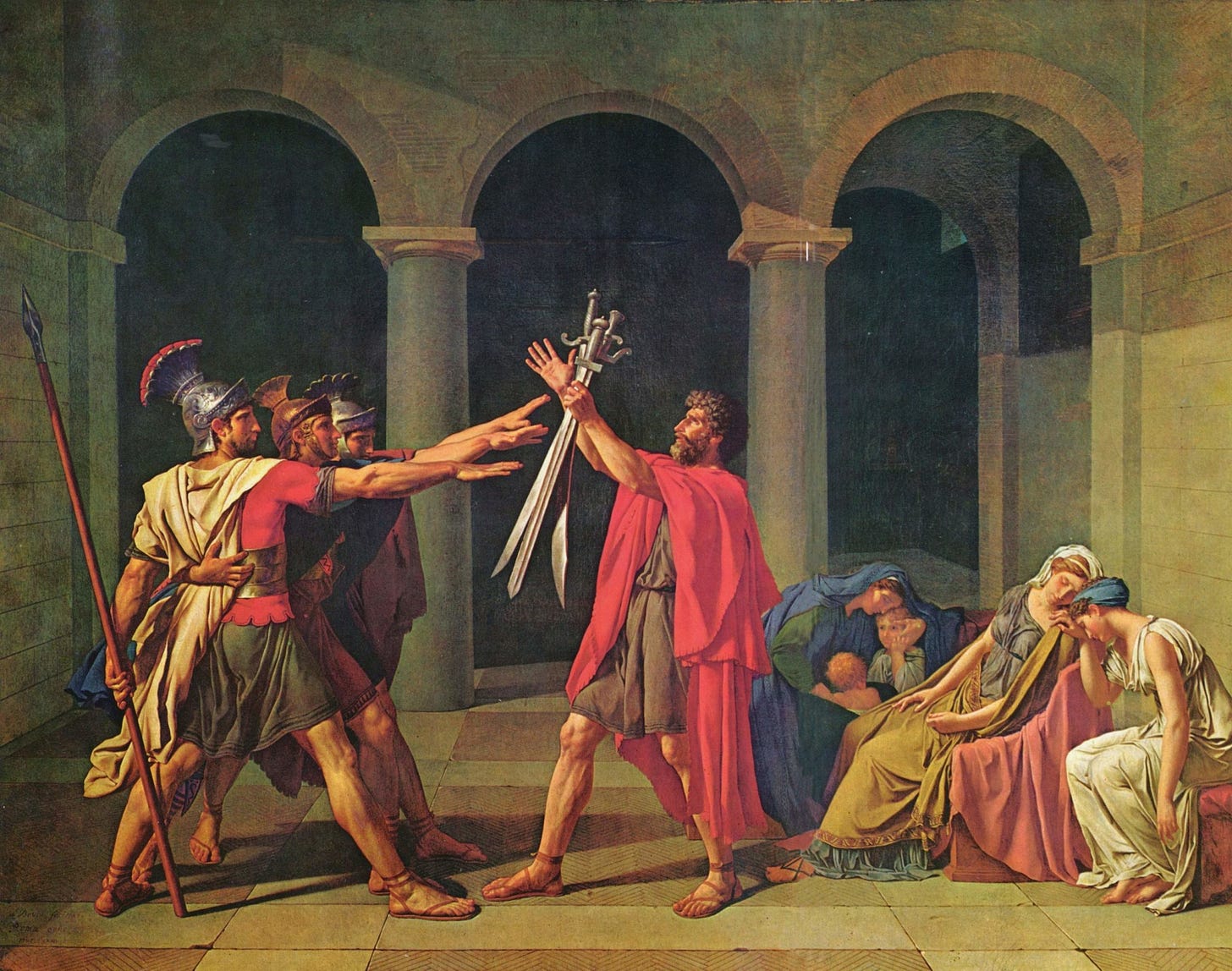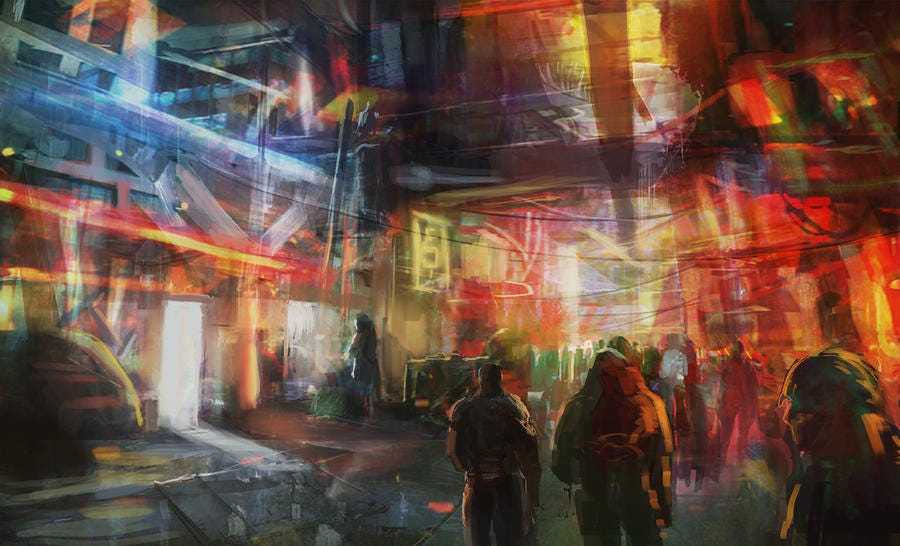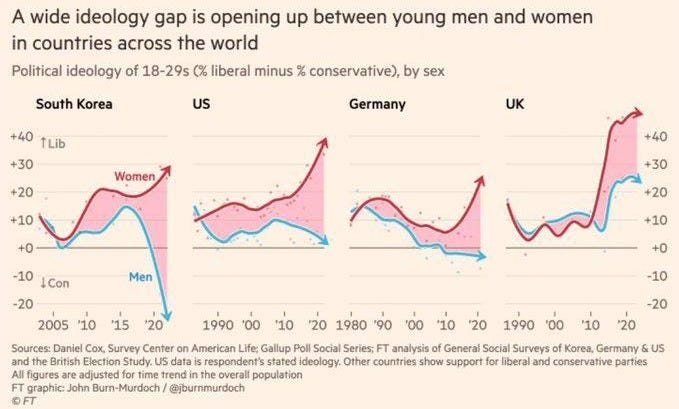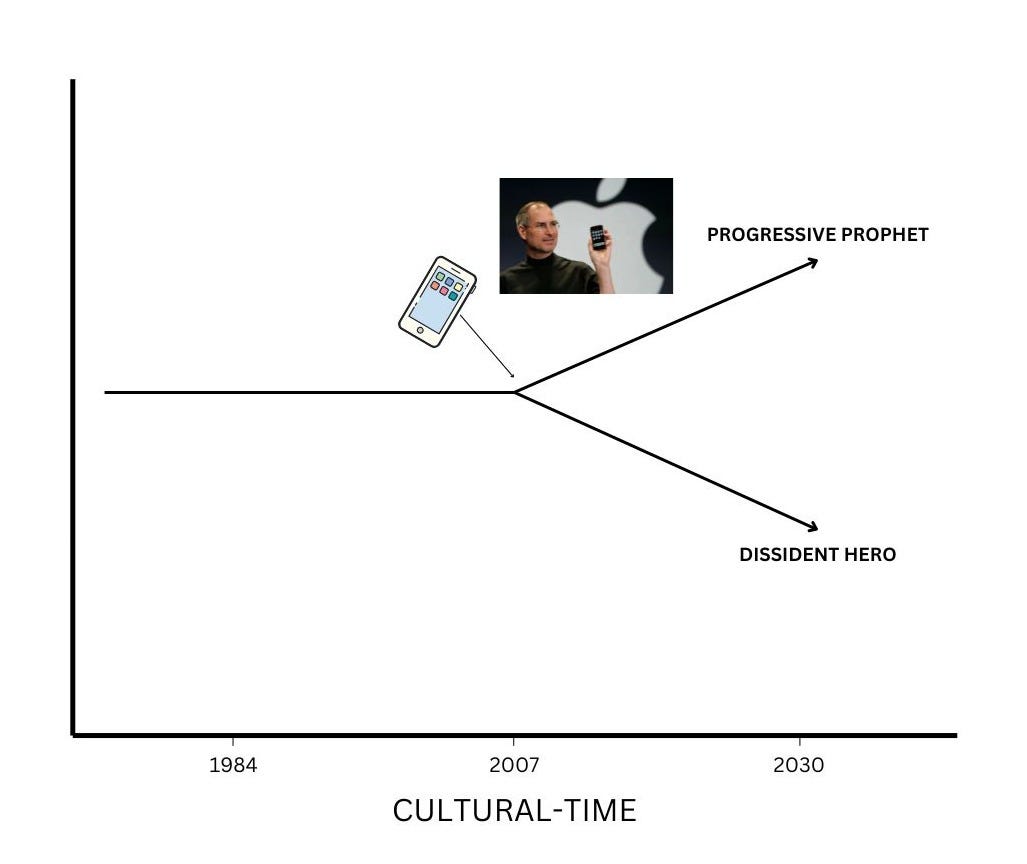The Fourth Turning
In 1997, The Fourth Turning was released, a book theorising recurring socio-psychological generational archetypes in Anglo-American history. The authors, William Strauss and Neil Howe, believed that Millennials would grow up to become the next ‘Hero Generation’.
Strauss and Howe maintained that generations within relatively free societies would naturally subvert the behaviours and beliefs of the generations that preceded it - to a point. The personalities of generations are limited to four distinct archetypes that come of age during their relative social event or ‘turning’ they and/or preceding generations helped create:
The Artist, a sensitive and creative empath, comes of age during a High, the civic renaissance after a Crisis
The Prophet, an idealistic moral crusader, comes of age during an Awakening, a spiritual upheaval of the cultural and political High
The Nomad, a tough and resourceful individualist, comes of age during an Unravelling, an embrace of the liberating social release of the Awakening
The Hero, a powerful leader and builder, comes of age during a Crisis, a major national or international threat put off during an Unravelling
Given there are only four archetypes and four ‘turnings’, the personalities of generations repeat, despite dramatic changes in moral norms and environmental conditions. A new generation might appear markedly different in beliefs and behaviour than the generation preceding it, but markedly similar to a generation that lived a century earlier. The rough century of repeating time the authors call a ‘long human life’ or saeculum.
Strauss and Howe scoured Anglo-American history all the way back to the medieval era, and identified each distinct archetype linked with their corresponding turning. For the twentieth century each generation and its archetype and turning unfolded as follows:
The G.I. Generation, born between 1901 and 1924, were Heroes, that needed to cope with the Crisis period extending from the Great Depression to World War II
The Silent Generation, born between 1925 and 1942, were Artists, that helped maintain the High established by the G.I. Generation, after World War II
The Baby Boomers, born between 1943 - 1960, were Prophets, who radically challenged spiritual and social assumptions bringing about the Post-Modern and Civil Rights Awakening of the 1960s onto the 1970s
Generation X, born between 1961 - 1980, were Nomads, who fended for themselves in the social Unravelling after the Awakening epitomised by the crime wave in the 1990s
The next generation then, the Millennials, born between 1981 - 2000, were supposed to be the next Heroes, to come of age during a Crisis period in the second half of the first quarter of the 21st Century, which Strauss and Howe called ‘The Fourth Turning’. Depending on your definition of crisis, the external conditions of this prediction add-up, and arguably as does the Millennial personality archetype of being team-orientated, community-focussed, institution rejuvenators and builders. Strauss and Howe also suggested that as Millennials aged they were to become powerful leaders who helped establish another civic renaissance, or High.
As you will see, the Hero Millennial story is compelling, however this is not the only story that can be told about Millennials. When they were coming of age they arguably spearheaded the social and spiritual movement we now call Wokeness, which, under Strauss and Howe’s definitions of ‘turnings’, could be defined as an Awakening. If so, it would categorise Millennials as Prophets, rather than Heroes, and break the deterministic cycle from turning to turning and archetype to archetype, that much of their thesis relies upon.
Presented below are both stories, the Hero Millennial and the Prophet Millennial. What follows is my own working hypothesis the Bifurcation of the Generation, briefly detailing the way in which technological innovations such as the internet, smartphones, and social media, have created digital networks and ecosystems often split by political ideology, which prevents younger generations from sharing the same experiences. If an age-group does not share the same experiences, then one could argue they are not of the same generation, meaning, if we accept the existence of generation archetypes, that both the Hero Millennial and the Prophet Millennial can coexist as functioning societal archetypes. Under Strauss and Howe’s definitions, the Hero and the Prophet are shadows of one another (or subversions), which might preclude a war on the mythological level between the two dominant archetypes of Millennials.
However, as I speculate in the conclusions section, much of this outcome depends on the validity firstly of the hypothesis itself, and secondly, whether the bifurcation actually affected Millennials. Even if the hypothesis holds up, it may have only largely affected Zoomers, with Millennials being the last generation to enjoy a unification of social, spiritual, and political phenomena, which of course is expressed on the psychological level, and includes identity, beliefs, and behaviour. If so, either the Hero Millennial or the Prophet Millennial is in the minority, and will get ‘washed out’ by the other, dramatically determining the social and cultural course of history in the coming decades, especially given Millennials inevitable rise to power because of their generational population size and the fact the Boomers are about to relinquish it themselves.
But first, here’s the Millennial Hero story.
The Millennial Hero Story

On first glance, and given I myself was born in 1992, the Hero Millennial is compelling. Millennials were raised by tough and individualist older Generation X parents (or younger Boomers), who after being under-protected as children, made sure their own children received the care and attention they deserved (the typical childhood of the ‘Hero’). After experiencing wild adventures in their late teenage and early twenties as the Unravelling came to a close, Millennials found their way, begun successful careers, started families, and bought property.
In the midst of this ‘coming of age’ period, they endured and valiantly resisted a Crisis: The start of the Cold War with China; the economic depression initiated by the Wall Street crash of 2008 and continuing into the middle of the 2020s; major political polarisation and social upheaval, resulting in Occupy, Black Lives Matter, and MAGA; the logical (and absurd) conclusion of the Post-Modern and Civil Rights Awakening of the 1960s, including intersectionality, transgenderism, and affirmative action; and, perhaps the epitome of the Crisis, the tyranny of the COVID lock-downs and mandates, when many Millennials had just started families and bought their first homes.
In the 2030s and 2040s, one might look back and describe the sacrifices Millennials made, re-orientating their economic expectations, suffering through social absurdities and governmental tyrannies, rejuvenating corrupt institutions or building new ones in response, all while raising young families, as Heroic. Right-leaning commentators may argue the election of Trump and Vance in 2024 as the final bulwark from which behind Millennials were able to establish a new ‘normal’: A revitalisation of the social values of community, church, and family; a restructuring of institutions away from equal representation, toward excellence and meritocracy; and a renewal of pride in one’s land, nation, and peoples.
Not only is this story compelling to me because it is my story and the future I wish to live up to, but some anecdotal evidence supports it: A year or so after COVID, I met with best friends, all born 1992, some of whom I hadn’t seen for years. Many had matured, started families, begun successful careers, bought property, and if not right wing dissidents, then decidedly anti-woke and free-thinking. Given our wild adventures together in the Unravelling, and the social, spiritual, and economic shock of the following Crisis, I was proud of them. We, all in our own small way, were being Heroes: For our wives and girlfriends, our children or future children, for each other, and for wider society.
But I knew many Millennials who weren’t like us. Some lived in narcissistic dreams of entitlement, decadence, and moral righteousness. Others were submissive and cowardly, and went along with censorship and cancellation, lock-downs and mandates, and the social absurdities - even if they disagreed with all of them. The women were especially domineering and selfish, and the men were embarrassingly cuck-hold.
I wondered whether it was possible for a generation and its turning to recur before it is supposed to, perhaps because of a suppression of a turning (World War III failing to occur) or a technological innovation (the dotcom to social media boom). What if, instead of being valiant Heroes who help established a new High, we, the Millennials, were narcissistic moral crusaders who spearheaded the destructive social and spiritual movement called Wokeness?
What if Millennials were Prophets?
The Millennial Prophet Story
The Prophet Millennial is equally compelling. With the cost of consumption rapidly diminishing, older Generation X and younger Boomers parents, who had comparatively little, indulged their precious Millennial children. The Millennials were incentivised to maintain the narcissistic world of the infant, to realise the certainty of their thoughts and feelings, and as they grew, to view self-fulfillment as the number goal in life. Self-fulfillment, by definition, could mean literally anything because it is defined by the individual. But as Rene Girard might say, what was to be fulfilled was dependent on what their peers wanted or desired. Self-fulfillment is mimetic and therefore a paradox.
The first, and arguably most common desire, was a continuation of the consumption initiated by their parents and the Boomers. The older ones became addicted to alcohol and drugs, the younger ones played video games, watched porn, and scrolled social media, and all ate too much. The second, if they were intelligent and disciplined, and especially if they were women, placed careerism above all else, and worked tirelessly to achieve material ‘transcendence’ through the ‘happiness’ derived from their job. The third, for the intellectually and spiritually orientated few, and what would come to define the Millennials turning, was an attempt to fill the void that the above two mimetic desires helped create: The answer to the question, “Who Am I?”
But, because it was mimetic, not every answer was socially acceptable. And the answers that were acceptable, the self that could be fulfilled, was the type of self that had been suppressed psychologically for so long: The Negative Identity.
The Negative Identity
The Prophet archetype is defined by moral superiority over previous generations, derived through inner revelation. They aim to liberate the individual from past oppressive norms and laws. The reflective and ‘self-aware’ Millennials, especially the younger ones, did not want to be defined as continuators of what they viewed as historical injustices. Arguably the most important was the ‘irredeemable’ fact that anybody who varied too far from the norm was socially ostracised: Ethnic minorities, homosexuals, transgenders, nerds, girl-bosses, metrosexuals, the disabled, until we reached its logical conclusion, paedophiles.
Yet the celebration of these different people, these deviations from the norm, could not alone satisfy the movement that came to known as Wokeness. There were too few of these individuals. It needed more energy, more mainstream involvement. Thus it encouraged in people who fitted safely within the ‘normal’, to lean into the different or ‘unique’ parts of their identity, their Negative Identity: The parts of themselves that society has historically shunned, usually because of their maladaptive quality, but sometimes out of pure arbitrariness.
Men were encouraged to embrace their inner feminine, indulge their vulnerable side, become child rearers, and even cry (an early formation was the ‘New Man’ in the UK in the 1990s-2000s). Women, by contrast, were encouraged to fill the masculine void left by men and become men themselves, by being assertive and domineering providers, who were often aloof and emotionally distant. The ‘neuro-divergent’ movement flipped inherent abnormality into a desired social category, to the point where younger people felt left out if they didn’t have a mental-disorder (diagnosis of many conditions have sky-rocketed in the last 10-20 years). The trans-movement was the epitome, where embodiment of the Negative Identity was taken literally: Boys and girls ‘became’ the opposite sex through gender-reassignment surgery, at least in their eyes. Over the past 60 years, the excluded became the weird, became the accepted, became the Celebrated.
If the Millennials are Prophets, one might look back in the 2030s and 2040s and say they were behind the spiritually catastrophic Awakening called Wokeness. If so, it would mean Strauss and Howe’s deterministic cycle, of season to season, turning to turning, would be broken. Instead of preceding from Awakening to Unravelling to Crisis to a future High, ‘time’ or ‘history’ skipped the Crisis and the rejuvenated High, and went straight to another Awakening. The archetypal personality of the Millennial, instead of Heroes fighting off a Crisis, would then mirror the generation who enabled the 1960s and 70s Awakening, the narcissistic and indulgent Boomer, who had it easier than those both younger and older generations.
In fact,
asked this very question, in his piece Are Millennials Becoming Boomers? Furthermore, Jean Twenge, a generational psychologist, who has done much research on the damage of phones and social media on mental health, not only disagrees with Strauss and Howe’s thesis, but argues Millennials are more narcissistic than previous generations, a typical character trait of Prophets.So what story, the Hero or the Prophet, best typifies the average Millennial? Is it possible they both do?
The Bifurcation of the Generation

One of the central definitions of a ‘generation’ is that the collective age-group requires a shared experience, which includes everything from being raised the same, consuming the same pop-culture, to living through the same socio-political events like wars and technological innovations. In fact, without this ‘shared experience’ what binds a generation together falls away, to the point where even though they are the same age, they are not of the same ‘generation’.
This is best exemplified with immigrants. When large groups of individuals migrate to another country, and especially another culture, they are not of the same generation as natives who are of the same age. In Strauss and Howe’s language, their generational archetype is likely out of sync with the native population’s relative archetype, until they have children, and those children assimilate with the native culture.
With the advent of the internet and social media, which exasperated the individualism brewing in the late 1980s early 90s, culture fragmented. Over-time, digital ecosystems were formed, based around everything from taste in music, to sports-team bandwagons. As these technologies shifted from an overlay to the foundation of how ideas are shared and consumed in our societies, the experience of one young person to another might be orders of magnitude more different than what occurred between young people in older generations, to the point where young people today, even though they are of the same age are not of the same ‘generation’.
Of course, the age group this has affected most are the Zoomers, who to some observers, might seem wildly different in behaviour and belief not only to previous generations, but to each other. Arguably, this is best exemplified in the political polarisation of young men and women. One could say, given the vast differences in Zoomer’s social experience, what pop-culture they consume, the values they prioritise, that young leftists and rightists are so different they could be described as different generations.
In my own life, this hypothesis appears supported: In the week I attend University and see in the student-body the crystallisation of Wokeness in all its rainbow covered glory; on the weekend, I play cricket with brash, free-thinking young men, willing to say whatever they want, and thoroughly rejecting the social frame society has imposed upon them. The two populations are so different it sometimes feels like I’m living in two different countries at the same time.
But what if this bifurcation has also occurred with Millennials? Although one could make a strong case for them being the last generation to experience unification, they still are consuming radically different narratives about socio-political events, and more importantly, their place in history as defined by both themselves and others. This leads to the possibility of the Hero Millennial and the Prophet Millennial archetypes coexisting.
Conclusions: The Dissident Hero versus The Progressive Prophet
Of course, what I have written is mostly speculative and more of a ‘jumping off point’ than anything concrete. However if we accept that generation archetypes exist, but not necessarily the deterministic cycle of turning to turning and archetype to archetype (meaning the cycle is more fluid, and revert or skip far quicker than the past, perhaps because of technology), we can come up with some possibilities for the future.
The Dissident Hero versus The Progressive Prophet
If we accept that Millennials are bifurcated like Zoomers, the implications of having two different generations of the same age, living side by side, could be cataclysmic. Using the iPhone release year, 2007, as a relatively arbitrary cut-off point, history - or ‘cultural time’ - would bifurcate alongside each generation. Within their own cultural timeline, each generation, the shadow of each other, Hero versus Prophet, would wage a mythological war of epic proportions.
Given the Millennials are large in terms of numbers, and given the current power-holders, Boomers, are about to die, the victor of this war (if there ever is one) could come to define what period we are living in now and what socio-political events might occur in the future. If the Dissident Hero and the Progressive Prophet ‘agree to disagree’, we could see birth of powerful separatist movements, with Dissidents reunifying on a lower, more local level, and desiring to split from their Progressive Prophet overlords (or counterparts).
The Progressive Prophets are a Vocal Minority and will be Washed Out
If we argue that Millennials are not bifurcated like Zoomers (maybe only the younger ones), then it leads us to conclude that maybe only one of the above stories I told can be the Millennial generational archetype. Depending on one’s environment, either story may feel more persuasive to you. You may work in a university or urban setting, and see 25 - 45 year olds acting like Progressive Prophets, where the only future they see for the populace is intersectional dominance. Or, you may know or be a Dissident Hero, who is rejecting rampant social ‘liberation’, socialist-globalist economic policy, and infinite-immigration, while desiring reunification of culture around historically adaptive norms, much like Strauss and Howe predicted Millennials would.
My guess is that Progressive Prophets are an extremely vocal minority, and because of a combination of progressive cronyism in elite institutions and social media outrage mechanics, have appeared as a far greater cohort of Millennials than they actually are. Even if Millennials were late teenagers/early twenty-somethings progressives, they may have performed the classic ‘conservative maturation’ upon reaching 30, leaving much of their young utopianism behind. Certainly, this appears true to people I know in my own personal life, even those who were once radically left when they were at University.
Bifurcation? More like Infinite Division.
Broad political polarisation may only be a façade for more diverse division. As I mentioned earlier, recent technological innovations like smart-phones and social media, have split people based on almost everything, from music taste to sports-team bandwagons. This effects politics too, as many writing online understand. Within the ‘online-right’, there are several sub-groups vying for power and control (and cooperation), and likely within those subgroups, they are divided further. If we apply this division to a generation, it’s possible all four of Strauss and Howe’s archetypes coexist within one age-group, each with their own narrative about their place in the world and how history is unfolding.
What might this mean? A four-way war for the writing of history? Maybe. But some, like Martin Gurri in The Revolt of the Public, suggests that the splintering of culture as a result of social media and related technologies, predicts stagnation rather than anything cataclysmic.
Thank you all for reading!
If you enjoyed this, please consider giving it a like, or if you have some thoughts, share them in the comments.
Even better, click this button…
If you want to support me further, and help me realise my dream of becoming an independent writer and voice, you can upgrade to a paid subscription or you can simply give me a tip.
Chur, and have a good day and night,
The Delinquent Academic









I don't particularly like Strauss and Howe theory on the basis that it's sufficiently vague as to apply to both nothing and everything. It encourages cherry-picking in terms of analyzing human behavior. With that said, this is an interesting observation.
There has certainly been a dramatic cultural bifurcation. I think that when looking at these scenarios in a long-term lens, one cannot ignore the effects of demographics. Historically, Strauss and Howe theory was built around a number of cultural and economic assumptions. One of the most important assumptions is an ever-growing economy and population. One could reasonably argue that the Millennial generation was the first to properly recognize that they live in a time that is culturally unprecedented for around 500 years: a shrinking population and economy. The demography plays a critical role as civilizations with older populations demonstrate less vitality and less propensity to change. This calls into question many of the assumptions of Strauss and Howe theory to begin with.
Further, demography will play a critical role moving forward. The "woke" portion of the millennial population is far less likely to pass on their beliefs to the next generation. The dissident right frequently see child-rearing as duty while the Woke left sees it as a nuisance. From demography alone, the Millennial dissidents and zoomer-Right are going to dominate cultural discourse. What we're observing is a cultural phenomena and strife quite similar to the appearance of the printing press and the protestant reformation. Coincidentally, also the last time that a major demographic collapse took place in Western nations (that time due to war and famine). This is a period of instability in human history that we're going through now... sufficient instability that more short-lived deterministic theories that may have held true for the previous half-millennium are inapplicable.
Here's a downloadable link to The Fourth Turning.
https://archive.org/details/the-fourth-turning-an-american-prophecy-what-the-cycles-of-history-tell-us-about
It's one of the books I was thinking about when I wrote this, even though I linked to a Philip Dick book. Chose to link to Dick to send a message to certain politicians I know - though I doubt they'll get it.
https://craighutchinson.substack.com/p/covid-19-the-deadliest-fraud-ever
Good essay.